Webinar Summary & Recording: How are Ontario Student Nutrition Programs adapting during COVID?
Posted: June 14, 2021
Categories: Edible Education Network / Good Food Ideas for Kids / GoodFoodBites / News from Sustain Ontario / School Food News
On June 1, 2021, Sustain Ontario and Student Nutrition Ontario hosted a webinar on how Ontario Student Nutrition Programs are adapting in a time of COVID-19. A recording of the webinar is now available:
When schools closed last year, student nutrition programs (SNPs) could no longer operate as usual. How have Ontario SNPs been working to fill this gap in food access?
In this webinar, we heard from the following speakers on how they’ve moved to innovative delivery programs, food hampers, pick-up locations and pantries:
- Daniel Hobbs, Student Nutrition Program, Thunder Bay and District
- Gerard Capellan, Food and Logistics Coordinator, Toronto Foundation for Student Success
- Jillian McCallum, VON-OSNP Southwest
- Angela Fuchs, Student Nutrition Program, Central East Region
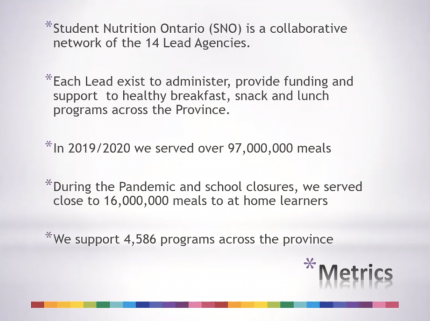 Below is a summary of the presentations, with time markers given in brackets.
Below is a summary of the presentations, with time markers given in brackets.
[00:00:01]
Carolyn Webb, Coordinator of Sustain’s Ontario Edible Education Network, welcomed participants to the event and shared words of appreciation for all those who made the time to join the call.
[00:07:03]
Viviane Dégagné, Manager of Student Nutrition Ontario (SNO), moderated the discussion and began by offering an overview of SNO and the upcoming presentations. [Dowload Viviane’s Slides]
[00:11:42]
Daniel Hobbs, Student Nutrition Program, Thunder Bay and District
- Daniel’s presentation focused on reaching at-home learners.
- Their team was able to build upon an established network to offer universally accessible food hampers at four pick-up locations throughout Thunder Bay. They had previously run food hamper programs, so that helped with having some procedures and relationships in place.
- They reached students and families mainly through electronic communication, such as email and other platforms the Boards were using for virtual learning. This way the families could decide themselves whether they wanted access to the food bags.
- Initially, they communicated about the food bags the day before a pick-up spot was scheduled, but their numbers increased once a weekly commitment was made for every Thursday. They went from 120 hampers to about 250 a week once all schools were locked down.
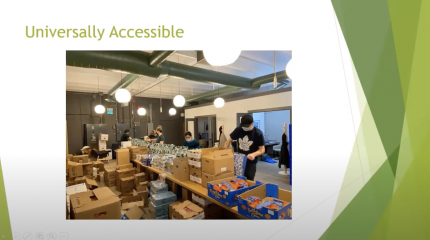 Initially, they focused on internal communication for online learners, but once some schools went to a hybrid online/in-person model, they did face a harder time targeting advertisements. But they worked to collect stats on schools/location in an effort to reach as many students as possible.
Initially, they focused on internal communication for online learners, but once some schools went to a hybrid online/in-person model, they did face a harder time targeting advertisements. But they worked to collect stats on schools/location in an effort to reach as many students as possible.- Partners included the Ontario Ministry of Children Community and Social Services, The Grocery Foundation, the Breakfast Club of Canada, the Northern Fruit & Vegetable Program, the Thunder Bay Catholic District School Board, Lakehead Public Schools, and Roots to Harvest (which is where the hampers were put together).
[00:20:45]
Gerard Capellan, Toronto Foundation for Student Success (TFSS)
- Gerard discussed the TFSS’s Nutrition Pantry Program, how it started, how it works, and its impact.
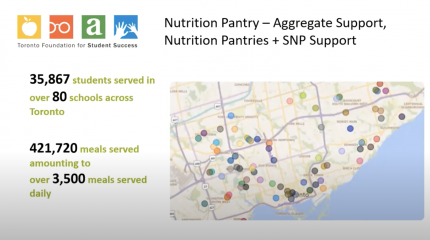 Simply put, they began the nutrition program out of a need to provide youth with healthy food in a non-stigmatizing way.
Simply put, they began the nutrition program out of a need to provide youth with healthy food in a non-stigmatizing way.- Last year, they set up COVID Nutrition Pantries in unused rooms in secondary schools, where students could go to select foods to take home. All items were healthy, shelf-stable options that were familiar to families.
- The pantries expanded upon a past program of theirs where they sent food out to schools on weekends.
- They were able to make this work thanks to space donated by the Toronto District School Board (TDSB), which was used as a distribution centre, offering the infrastructure to sort and pack food from a central location. There was a lot to figure out operationally and to reach catchment areas, but the space donated by the TDSB allowed them to accept in-kind food donations, purchase food in bulk with discounts, and get the food out to schools quickly.
- TFSS would purchase and assemble orders and coordinate shipments, and the TDSB provided logistical support and delivery to sites.
- This program supported 21 schools initially, and eventually expanded to elementary students and schools, where they shipped out individual packages to an additional 63 elementary programs, for a total of 84 schools; 35,867 students were served 421,720 meals, amounting to over 3,500 meals served daily.
[00:34:15]
Jillian McCallum, VON-OSNP Southwest
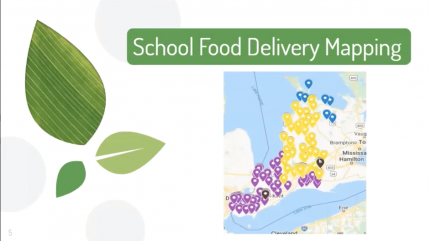 Jillian presented on how OSNP Southwest shifted to a direct delivery model to support their student nutrition programs.
Jillian presented on how OSNP Southwest shifted to a direct delivery model to support their student nutrition programs.- Schools opted out of receiving their OSNP grant and instead participated in this delivery program, which offered weekly produce deliveries and the opportunity to purchase and/or receive food credits for supplementary items.
- They offered two menu options with three intake periods (Nov – Dec 2020; Jan – March 2021; April – June 2021), which allowed them to adjust to needs as appropriate.
- Produce Express & Evans Wholesale were the two main distributors who facilitated direct delivery to schools on a weekly or bi-weekly basis.
- In this southwest region, there are just over 450 schools. In Phase 2, 220 schools participated in the food delivery program; and on average, 34,000+ students were reached daily in this phase.
- As the program progressed, partnership opportunities grew as well as community investments in enhancing menu offerings, which helped them tailor the program on an ongoing basis.
- Jillian also highlighted how this work created infrastructure opportunities and assisted in capacity challenges. She showed their online ordering platform, and explained how having trucks on the road offered the opportunity to streamline partnerships (e.g. food donations from the Breakfast Clubs of Canada).
- Because of positive feedback and partnerships built, they plan to continue this program into the future.
- “I loved the convenience of the program. It was so easy to place orders. Having the items come to the school reduced the number of hours that we had to spend organizing and buying for the breakfast program. I also love the boxes which we order for families. We have two families that we are supporting, and they are very appreciative.” – Marga Wilson, a Principal at one of the participating schools
[00:46:05]
Angela Fuchs, Student Nutrition Program, Central East Region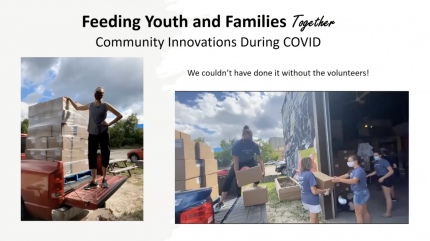
- Angela presented on the Student Nutrition Program in Peterborough City and County and how the community came together to launch an emergency food program.
- This area has student nutrition programs in 51 schools, serving about 17,000 students. Within days of schools closing, Angela received emails about food access from school staff, principals, and even parents.
- By this point, their funding and resources had already been allocated, so they needed to figure out how they could get food to students while navigating new protocols and barriers. Like all of our presenters, important partnerships were essential.
- Their long-standing relationship with Kawartha FoodShare led to a virtual meeting between them, the Bridge Youth Centre, and Peterborough Youth Services, which launched the Feeding Youth and Families Together Program. An established relationship with a principal also helped them to connect with families.
- The Bridge Youth Centre was used as the warehouse and pick-up location for families. Initially, the food was coming from emergency food boxes from Feed Ontario, but eventually they secured more partnerships and funding to purchase other products in bulk, such as fresh produce, dairy products and eggs.
- Once they had food and a location secured, they recruited volunteers to help with stocking and distribution. They started recruiting family, friends, past volunteers and committee members.
- 608 unique families were able to access the program over four months; 13,042 people were served 4,425 boxes, for a total of 148,598 pounds distributed.
After the four presentations, participants moved into break-out groups to share their own stories on how they have been adapting to COVID. A summary of what was discussed in the break-out groups begins at 00:58:25.
Thank you to our speakers and all who attended! And bravo to all who have been working tirelessly to keep our students nourished.
The massive interest in these adapted programs proves just how important school food is for our students and communities.
This webinar is part of Sustain’s school food webinar series on adapting to COVID-19. Recordings of past webinars in the series are available below:
- April 2020: Food Literacy Opportunities for Children and Youth while Schools are Closed
- November 2020: School Food Programming in Ontario in a time of COVID-19
- January 2021: Edible Education Programming in Ontario in a time of Covid – How to Make it Work?
